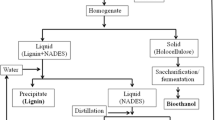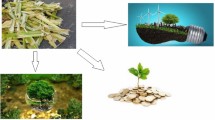Abstract
The cellulose-hydrolyzing strains, Sphingomonas paucimobilis MK1 and Bacillus circulans MK2, were separated from soil and were grown together in a single culture plate. Growth B. circulans MK2 in liquid culture required symbiosis with S. paucimobilis MK1. Biological pretreatment with the combined strain suspension after the liquid culture improved enzymatic hydrolysis of office paper from municipal wastes. Sugar recovery by S. paucimobilis MK1 (51%) was 1.4 times higher than that of the untreated sample (30%) and in the strain combination with B. circulans MK2, recovery was further improved by 2.5 times (75%). The sugar recovery in maximum condition was enhanced up to 94% for office paper. Furthermore, biological pretreatment effects were confirmed for more than 1 day less time. In X-ray diffraction patterns for the crystallinity of cellulose in office paper changed after biological pretreatment, the crystallinity was increased in comparison to that in untreated paper. The mechanism of biological pretreatment effect was explained by the fact that the strain acted as an endoglucanase, which hydrolyzes amorphous areas randomly.



Similar content being viewed by others
Literature Cited
Sun Y, Cheng J (2002) Hydrolysis of lignocellulosic materials for ethanol production: review. Bioresources Technol 83:1–11
Hsu TA, Himmel M, Schell D, Farmer J, Berggren M (1996) Design and initial operation of a high-solids, pilot-scale reactor for dilute-acid pretreatment of lingocellulosic biomass. Appl Biochem Biotechnol 57/58:3–18
Schell DJ, Farmer J, Newman M, McMillan JD (2003) Dilute-sulfuric acid pretreatment of corn stover in pilot-scale reactor. Appl Biochem Biotechol 105–108:69–85
Ander P, Eriksson KE (1977) Selective degradation of wood components by white-rot fungi. Physiol Plant 41:239–248
Hatakka AI (1983) Pretreatment of wheat straw by white-rot fungi for enzymic saccharification of cellulose. Eur J Appl Microbiol Biotechnol 18:350–357
Boominathan K, Reddy CA (1992) cAMP-mediated differential regulation of lignin peroxidase and manganese-dependent peroxidase production in the white-rot basidiomycete Phanerochaete chrysosporium. Proc Natl Acad Sci (USA) 89:5586–5590
Sneath PHA, Mair NS, Sharpe ME, Holt JG (ed.) (1986) Bergey’s manual of systematic bacteriology. Vol. 2. Baltimore, Williams and Wilkins
Huang SY, Chen JC (1988) Ethanol production in simultaneous saccharification and fermentation of cellulose with temperature profiling. J Ferment Technol 66: 509–516
Gaudet G, Gaillard B (1987) Vesicle formation and cellulose degradation in Bacteroides succinogenes cultures: ultrastructural aspects. Arch Microbiol 148:150–154
Morris EJ, Cole OJ (1987) Relationship between cellulite activity and adhesion to cellulose in Ruminococcus albus. J Gen Microbiol 133:1023–1032
Bhikhabhai B, Johansson G, Pettersson G (1984) Cellobiohydrolase from Trichoderma reesei: internal homology and prediction of secondary structure. Int J Peptide Protein Res 25:368–374
Tomme P, Tilbeurgh H, Pettersson G, Damme J, Vandekerckhove J, Knowels J, Teeri T, Claeyssens M (1988) Studies of the cellulolytic system of Trichoderma reesei QM9414. Eur J Biochem 170:575–581
Gilkes NR, Warren RAJ, Miller RCJ, Kilburn DG (1988) Precise excision of the cellulose binding domains from two Cellulomonas fimi cellulases by a homologous protease and the effect on catalysis. J Biol Biochem 263:10401–10407
Maglione G, Matsushita O, Russel JB, Wilson DB (1992) Properties of a genetically reconstructed Prevotella ruminicola endoglucanase. Appl Environ Microbiol 58:3593–3597
Eriksson KE, Pettersson B (1975) Extracellular enzyme system utilized by the fungus Sporotrichum pullverulentum (Chrysosporium lignorum) for the breakdown of cellulose 1. Separation, purification and physicochemical characterization of five endo-l,4-β-glucanases. Eur J Biochem 51:193–206
Wood TM, McCare SI (1978) The cellulase of Trichoderma koningii. Purification and properties of some endoglucanase components with special reference to their action on cellulose when acting alone or in synergism with the cellobiohydrolase. Biochem J 171:61–72
Author information
Authors and Affiliations
Corresponding author
Rights and permissions
About this article
Cite this article
Kurakake, M., Ide, N. & Komaki, T. Biological Pretreatment with Two Bacterial Strains for Enzymatic Hydrolysis of Office Paper. Curr Microbiol 54, 424–428 (2007). https://doi.org/10.1007/s00284-006-0568-6
Received:
Accepted:
Published:
Issue Date:
DOI: https://doi.org/10.1007/s00284-006-0568-6




